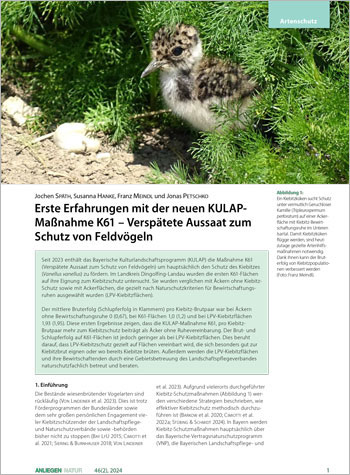Erste Erfahrungen mit der neuen KULAP-Maßnahme K61 – Verspätete Aussaat zum Schutz von Feldvögeln

Ein Kiebitzküken sucht Schutz unter vermutlich Geruchloser Kamille (Tripleurospermum perforatum) auf einer Ackerfläche mit Kiebitz-Bewirtschaftungsruhe im Unteren Isartal. Damit Kiebitzküken flügge werden, sind heutzutage gezielte Artenhilfsmaßnahmen notwendig. Dank ihnen kann der Bruterfolg von Kiebitzpopulationen verbessert werden (Foto: Franz Meindl).
Jochen Späth, Susanna Hanke, Franz Meindl und Jonas Petschko
Erste Erfahrungen mit der neuen KULAPMaßnahme K61 – Verspätete Aussaat zum Schutz von Feldvögeln
Seit 2023 enthält das Bayerische Kulturlandschaftsprogramm (KULAP) die Maßnahme K61 (Verspätete Aussaat zum Schutz von Feldvögeln) um hauptsächlich den Schutz des Kiebitzes (Vanellus vanellus) zu fördern. Im Landkreis Dingolfing-Landau wurden die ersten K61-Flächen auf ihre Eignung zum Kiebitzschutz untersucht. Sie wurden verglichen mit Äckern ohne Kiebitz-Schutz sowie mit Ackerflächen, die gezielt nach Naturschutzkriterien für Bewirtschaftungsruhen ausgewählt wurden (LPV-Kiebitzflächen).
Der mittlere Bruterfolg (Schlupferfolg in Klammern) pro Kiebitz-Brutpaar war bei Äckern ohne Bewirtschaftungsruhe 0 (0,67), bei K61-Flächen 1,0 (1,2) und bei LPV-Kiebitzflächen 1,93 (1,95). Diese ersten Ergebnisse zeigen, dass die KULAP-Maßnahme K61, pro Kiebitz-Brutpaar mehr zum Kiebitzschutz beiträgt als Äcker ohne Ruhevereinbarung. Der Brut- und Schlupferfolg auf K61-Flächen ist jedoch geringer als bei LPV-Kiebitzflächen. Dies beruht darauf, dass LPV-Kiebitzschutz gezielt auf Flächen vereinbart wird, die sich besonders gut zur Kiebitzbrut eignen oder wo bereits Kiebitze brüten. Außerdem werden die LPV-Kiebitzflächen und ihre Bewirtschaftenden durch eine Gebietsbetreuung des Landschaftspflegeverbandes naturschutzfachlich betreut und beraten.
Summary
First experiences with the new KULAP measure K61 (delayed sowing to protect field birds) in the lower Isar Valley
Since 2023, the Bavarian Cultural Landscape Program (KULAP) has included the measure K61 (delayed sowing for the protection of field birds), primarily to promote lapwing (Vanellus vanellus) protection. In the district of Dingolfing-Landau, the suitability of the first K61 fields for lapwing protection was analysed. They were compared with fields without delayed sowing and fields with a non-disturbance agreement on specifically selected LPV lapwing areas.
The mean breeding success (hatching success in brackets) per lapwing breeding pair was 0 (0.67) on fields without an agreement on non-disturbance, 1.0 (1.2) on K61 plots and 1.93 (1.95) on lapwing plots of the local landcare organisation (LPV). These initial results show that the KULAP measure K61 improves lapwing protection per breeding pair compared to fields without delayed sowing. However, the breeding and hatching success on K61 plots is lower than on LPV lapwing plots. This is because LPV lapwing protection is agreed specifically for fields that are particularly suitable for lapwing breeding or where lapwings are already breeding. In addition, the LPV lapwing fields are supervised and their farmers advised by nature managers of the landcare organisation.
Zum Volltext-Download:
Anliegen Natur 46/2 (2024): 8 Seiten als Volltext herunterladen (pdf barrierefrei 0,8 MB).
 | 0
| 0 
